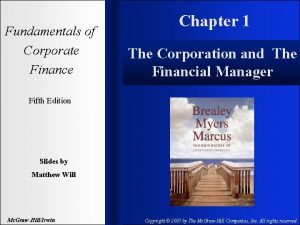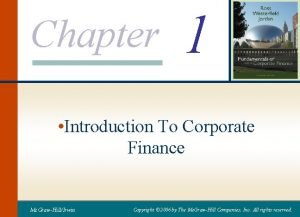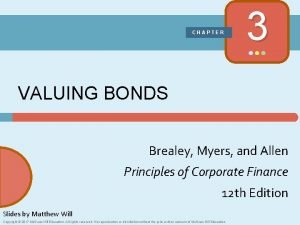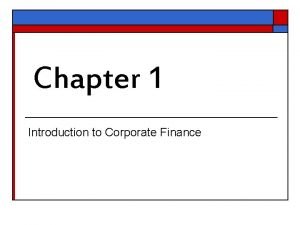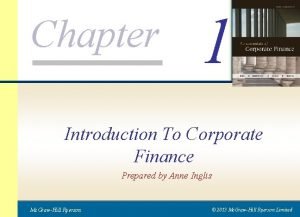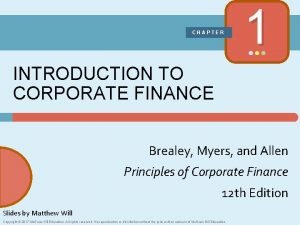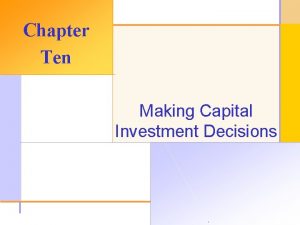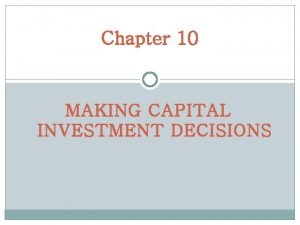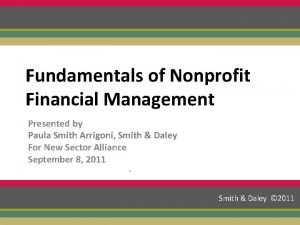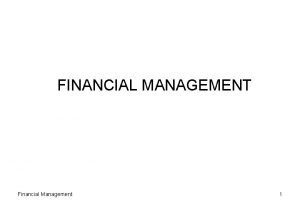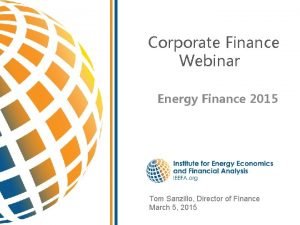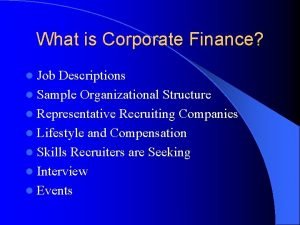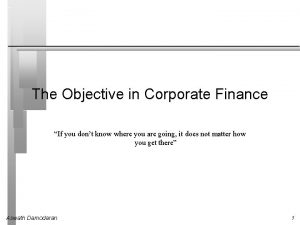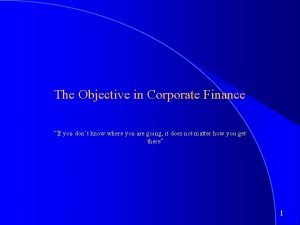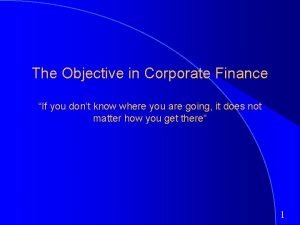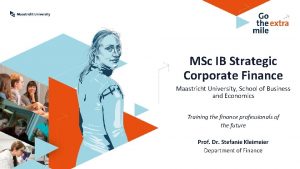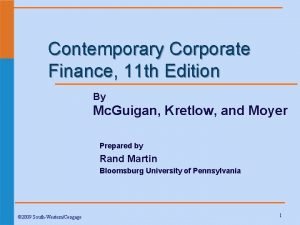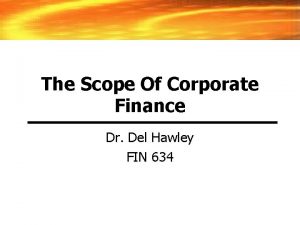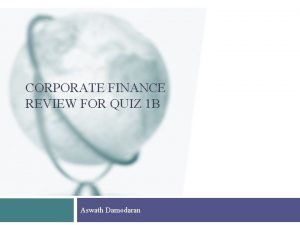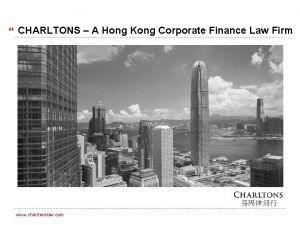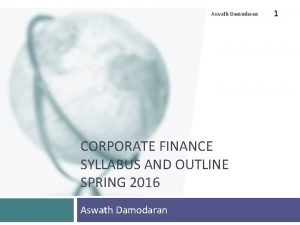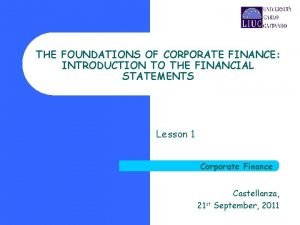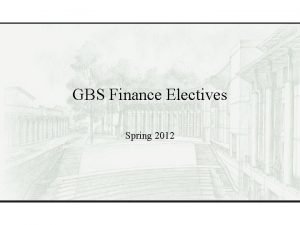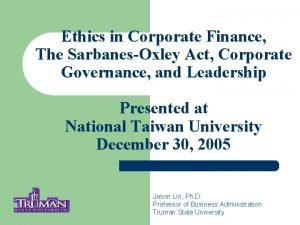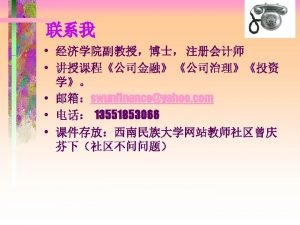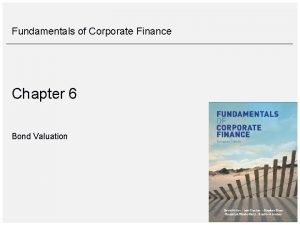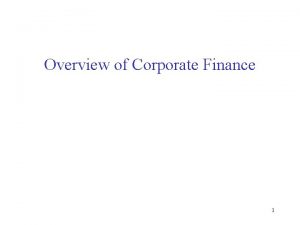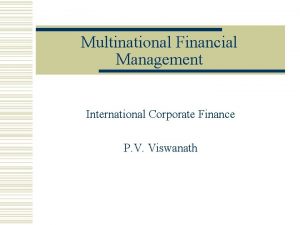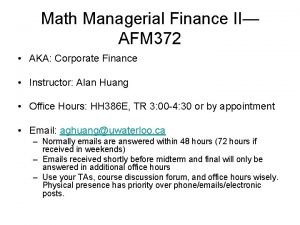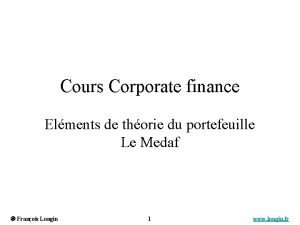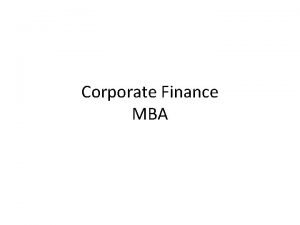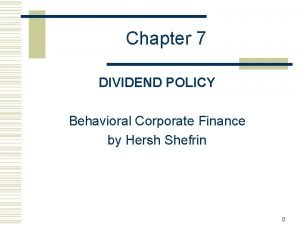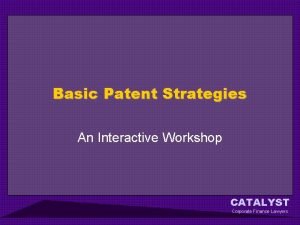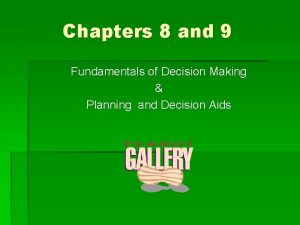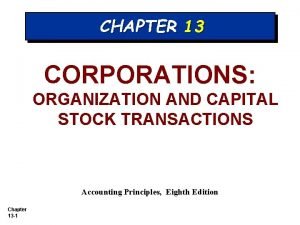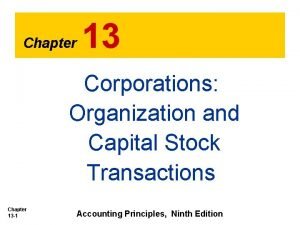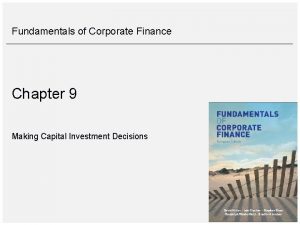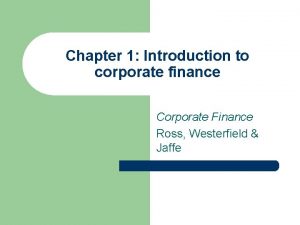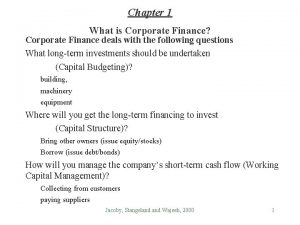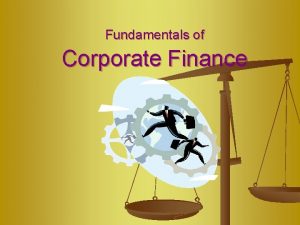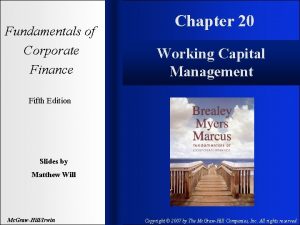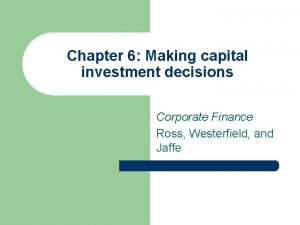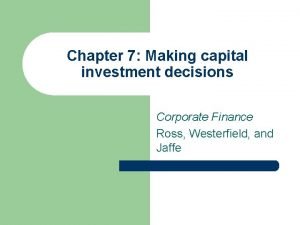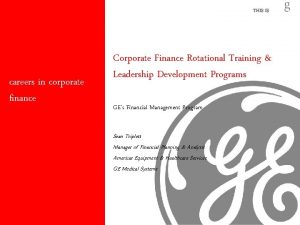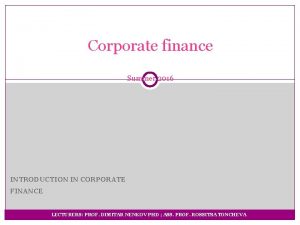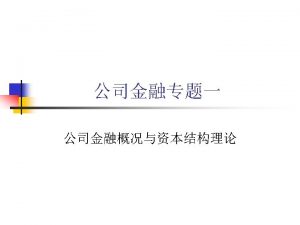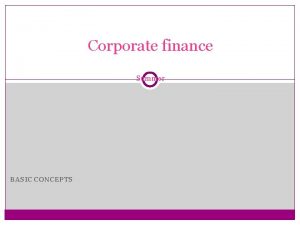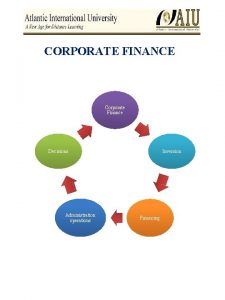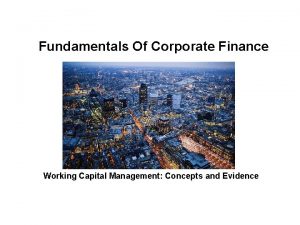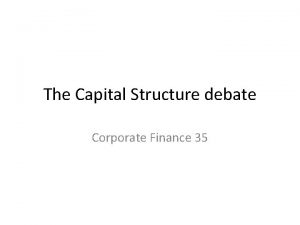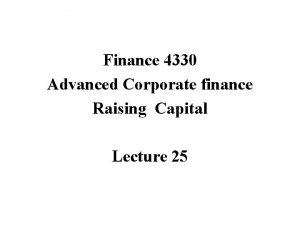Fundamentals of Corporate Finance Chapter 9 Making Capital




















































- Slides: 52

Fundamentals of Corporate Finance Chapter 9 Making Capital Investment Decisions

Overview of Lecture Project Cash Flows: A First Look Incremental Cash Flows Pro Forma Financial Statements More About Project Cash Flow Alternative Definitions of OCF DCF: Special Cases

Corporate Finance in the News Insert a current news story here to frame the material you will cover in the lecture.

Incremental Cash Flows The difference between a firm’s future cash flows with a project and those without the project. The incremental cash flows for project evaluation consist of any and all changes in the firm’s future cash flows that are a direct consequence of taking the project.

The Stand-Alone Principal The assumption that evaluation of a project may be based on the project’s incremental cash flows.

Incremental Cash Flows Sunk Costs Side Effects Opportunity Costs Allocated Costs

Incremental Cash Flows Sunk Cost • A cost that has already been incurred and cannot be removed and therefore should not be considered in an investment decision. Opportunity Cost • The most valuable alternative that is given up if a particular investment is undertaken.

Incremental Cash Flows Side Effects • The cash flows of a new project that come at the expense of a firm’s existing projects. Net Working Capital Financing Costs

Pro Forma Financial Statements Financial statements projecting future years’ operations.

Pro Forma Financial Statements We think we can sell 50, 000 cans of shark attractant per year at a price of £ 4 per can. It costs us about £ 2. 50 per can to make the attractant, and a new product such as this one typically has only a three-year life. We require a 20 per cent return on new products. Fixed costs for the project, including such things as rent on the production facility, will run £ 12, 000 per year. Further, we will need to invest a total of £ 90, 000 in manufacturing equipment. For simplicity, we will assume that this £ 90, 000 will be 100 per cent depreciated straight line over the three-year life of the project. Furthermore, the cost of removing the equipment will roughly equal its actual value in three years, so it will be essentially worthless on a market value basis as well. Finally, the project will require an initial £ 20, 000 investment in net working capital, and the tax rate is 34 per cent.

Pro Forma Financial Statements

Pro Forma Financial Statements

Project Cash Flows Project OCF Project CAPEX Project Cash Flow

Project Operating Cash Flow (OCF) Operating cash flow = Net Income + Depreciation Increase (+ Decrease) in Net Working Capital

Project Operating Cash Flow

Project Value NPV = £ 110, 000 + 51, 780/1. 22 + 71, 780/1. 23 = £ 10, 648

A Closer Look at Net Working Capital Suppose that during a particular year of a project we have the simplified income statement (next slide). Depreciation and taxes are zero. No non-current assets are purchased during the year. Also, to illustrate a point, we assume that the only components of net working capital are trade receivables and payables. The beginning and ending amounts for these accounts are also shown in the next slide. Based on this information, what is total cash flow for the year?

A Closer Look at Net Working Capital

A Closer Look at Net Working Capital Total cash flow = Operating cash flow Change in NWC Capital spending = € 190 ( 25) 0 = € 215

Example 9. 1 Cash Collections and Costs For the year just completed, Combat Womble Telestat plc (CWT) reports sales of £ 998 and costs of £ 734. You have collected beginning and ending statement of financial position information. Based on the figures in the next slide, what are cash inflows? Cash outflows? What happened to each account? What is net cash flow?

Example 9. 1 Cash Collections and Costs Sales were £ 998, but receivables rose by £ 10. So cash collections were £ 10 less than sales, or £ 988. Costs were £ 734, but inventories fell by £ 20. This means that we didn’t replace £ 20 worth of inventory, so costs are actually overstated by this amount. Also, payables fell by £ 30. On a net basis, we actually paid our suppliers £ 30 more than we received from them, resulting in a £ 30 understatement of costs. Adjusting for these events, we calculate that cash costs are £ 734 20 + 30 = £ 744. Net cash flow is £ 988 744 = £ 244. Finally, notice that net working capital increased by £ 20 overall.

Depreciation Reducing Balance Straight Line • A depreciation method under allowing for the accelerated writeoff of assets under various classifications. • A depreciation method allowing for a linear writeoff of assets over their lifetime.

Depreciation Straight line depreciation: Assume that you purchase an asset for € 500, 000, which has a five year life, and at the end of its life, the asset will be worthless. Since the asset’s life is five years and its residual value is zero, the annual depreciation will be: Annual Depreciation = € 500, 000/5 = € 100, 000

Depreciation 20% Reducing Balance:

Example 9. 2 Reducing Balance Depreciation Staple Supply Ltd has just purchased a new computerized information system with an installed cost of € 160, 000. What are the yearly depreciation allowances if 20 per cent reducing balance depreciation is used? Based on historical experience, we think that the system will be worth only € 10, 000 when Staple gets rid of it in four years. What are the tax consequences of the sale if the tax rate is 34 per cent? What is the total after-tax cash flow from the sale?

Example 9. 2 Reducing Balance Depreciation If Staple sells the system for € 10, 000 at the end of Year 4, it will have a loss of € 55, 536 for tax purposes. What really happens? Two things. First, Staple gets € 10, 000 from the buyer. Second, it saves. 34 € 55, 536 = € 18, 882 in taxes. So, the total aftertax cash flow from the sale is a € 28, 882 cash inflow.

Example: Majestic Mulch and Compost Ltd (MMC) MMC is investigating the feasibility of a new line of power mulching tools aimed at the growing number of home composters. Based on exploratory conversations with buyers for large garden shops, MMC projects unit sales as shown in the next slide. The new power mulcher will sell for £ 120 per unit to start. When the competition catches up after three years, however, MMC anticipates that the price will drop to £ 110. The power mulcher project will require £ 20, 000 in net working capital at the start. Subsequently, total net working capital at the end of each year will be about 15 per cent of sales for that year. The variable cost per unit is £ 60, and total fixed costs are £ 25, 000 per year. It will cost about £ 800, 000 to buy the equipment necessary to begin production. This investment is primarily in industrial equipment, which should be depreciated using the 20 per cent reducing balance method. The equipment will actually be worth about 20 per cent of its cost in eight years, or. 20 £ 800, 000 = £ 160, 000. The relevant tax rate is 28 per cent, and the required return is 15 per cent. Based on this information, should MMC proceed?

Example: Majestic Mulch and Compost Ltd (MMC)

Example: Majestic Mulch and Compost Ltd (MMC)

Example: Majestic Mulch and Compost Ltd (MMC)

Example: Majestic Mulch and Compost Ltd (MMC)

Example: Majestic Mulch and Compost Ltd (MMC)

Example: Majestic Mulch and Compost Ltd (MMC)

Example: Majestic Mulch and Compost Ltd (MMC)

Alternative Definitions of Operating Cash Flow Bottom Up Approach Top Down Approach Tax Shield Approach

Special Cases of DCF Analysis Evaluating Cost Cutting Proposals Setting the Bid Price Evaluating Equipment Options with Different Lives

Example 9. 3 To Buy or Not to Buy We are considering the purchase of a € 200, 000 computer-based inventory management system. It will be depreciated 20 per cent reducing balance over its four-year life. It will be worth € 30, 000 at the end of that time. The system will save us € 60, 000 before taxes in inventory-related costs. The relevant tax rate is 39 per cent. Because the new setup is more efficient than our existing one, we will be able to carry less total inventory and thus free up € 45, 000 in net working capital. What is the NPV at 16 per cent? What is the DCF return (the IRR) on this investment?

Example 9. 3 To Buy or Not to Buy

Example 9. 3 To Buy or Not to Buy At 16 per cent, the NPV is € 16, 157, so the investment is not attractive. After some trial and error, we find that the NPV is zero when the discount rate is 10. 62 per cent, so the IRR on this investment is about 10. 6 per cent.

Equivalent Annual Cost (EAC) The present value of a project’s costs calculated on an annual basis.

Investments of Unequal Lives: The Equivalent Annual Cost Method Date Machine 0 1 2 3 A € 500 € 120 B € 600 € 100 4 € 100

Investments of Unequal Lives: The Equivalent Annual Cost Method Assuming a discount rate of 10%, NPV is: What is problematic about this analysis?

Investments of Unequal Lives: The Equivalent Annual Cost Method Compare projects on a like-for-like basis Calculate the equivalent annual cost of each project

Investments of Unequal Lives: The Equivalent Annual Cost Method Machine A • NPV = € 798. 42 • Life is 3 Years Machine B • NPV = € 916. 99 • Life is 4 Years Equivalent Annual Cost • Calculate the equivalent annual cost of each Machine

Investments of Unequal Lives: The Equivalent Annual Cost Method Machine A: Date 0 Cash outflows of machine A Equivalent annual cost of machine A € 500 1 € 120 2 3 € 120 € 321. 05

Investments of Unequal Lives: The Equivalent Annual Cost Method Machine B: Date 0 Cash outflows of machine B Equivalent annual cost of machine B € 600 1 2 3 4 € 100 € 289. 28

Investments of Unequal Lives: The Equivalent Annual Cost Method Machine B: EAC = € 289. 28 Machine A: EAC = € 321. 05 Choose Machine B

Example 9. 4 Equivalent Annual Costs You are evaluating two different pollution control options. A filtration system will cost € 1. 1 million to install and € 60, 000 annually, before taxes, to operate. It will have to be completely replaced every five years. A precipitation system will cost € 1. 9 million to install but only € 10, 000 per year to operate. The precipitation equipment has an effective operating life of eight years. To simplify matters, straight-line depreciation is used throughout, and neither system has any salvage value. Which option should we select if we use a 12 per cent discount rate? The tax rate is 34 per cent.

Example 9. 4 Equivalent Annual Costs

Example 9. 4 Equivalent Annual Costs To decide which system to purchase, we compute the EACs for both using the appropriate annuity factors: Filtration system: € 973, 112 = EAC 3. 6048 EAC = € 269, 951 Precipitation system: € 1, 531, 650 = EAC 4. 9676 EAC = € 308, 328 The filtration system is the cheaper of the two, so we select it. In this case, the longer life and smaller operating cost of the precipitation system are not sufficient to offset its higher initial cost.

Activities for this Lecture Reading • Insert here Assignment • Insert here

Thank You
 Fundamentals of corporate finance chapter 6 solutions
Fundamentals of corporate finance chapter 6 solutions Fundamentals of corporate finance, chapter 1
Fundamentals of corporate finance, chapter 1 Fundamentals of corporate finance, chapter 1
Fundamentals of corporate finance, chapter 1 Fundamentals of corporate finance, third canadian edition
Fundamentals of corporate finance, third canadian edition Fundamentals of corporate finance canadian edition
Fundamentals of corporate finance canadian edition Fundamentals of corporate finance fifth edition
Fundamentals of corporate finance fifth edition Fundamentals of corporate finance 6th edition
Fundamentals of corporate finance 6th edition Objective of corporate governance
Objective of corporate governance Chapter 1 introduction to corporate finance
Chapter 1 introduction to corporate finance Principles of corporate finance chapter 3 solutions
Principles of corporate finance chapter 3 solutions Chapter 1 introduction to corporate finance
Chapter 1 introduction to corporate finance Chapter 1 introduction to corporate finance
Chapter 1 introduction to corporate finance Chapter 1 introduction to corporate finance
Chapter 1 introduction to corporate finance Tax shield formula
Tax shield formula Chapter 10 making capital investment decisions
Chapter 10 making capital investment decisions Finance fundamentals for nonprofits
Finance fundamentals for nonprofits Real estate finance fundamentals
Real estate finance fundamentals Modern financial theory
Modern financial theory Corporate finance webinar
Corporate finance webinar Investment banking activities
Investment banking activities Corporate finance job scope
Corporate finance job scope Objective of corporate finance
Objective of corporate finance Objectives of corporate finance
Objectives of corporate finance Objective of corporate finance
Objective of corporate finance Strategic corporate finance maastricht
Strategic corporate finance maastricht Contemporary corporate finance
Contemporary corporate finance Scope of corporate finance
Scope of corporate finance Objectives of corporate finance
Objectives of corporate finance Damodaran beta
Damodaran beta Charlton law firm
Charlton law firm Corporate finance tenth edition
Corporate finance tenth edition Corporate finance syllabus
Corporate finance syllabus Foundations of corporate finance
Foundations of corporate finance Gbs corporate finance
Gbs corporate finance Ethics in corporate finance
Ethics in corporate finance Corporate finance overview
Corporate finance overview Conservation of corporate finance
Conservation of corporate finance Corporate finance bonds
Corporate finance bonds Principles of corporate finance
Principles of corporate finance Examples of agency problems
Examples of agency problems Multinational corporate finance
Multinational corporate finance What is afm math
What is afm math Corporate finance cours
Corporate finance cours Nisan langberg
Nisan langberg Behavioral corporate finance shefrin
Behavioral corporate finance shefrin Corporate finance tenth edition
Corporate finance tenth edition Corporate finance tenth edition
Corporate finance tenth edition Corporate finance tenth edition
Corporate finance tenth edition Corporate finance tenth edition
Corporate finance tenth edition Catalyst corporate finance
Catalyst corporate finance Fundamentals of decision making
Fundamentals of decision making Accounting for corporations chapter 13
Accounting for corporations chapter 13 Accounting for corporations chapter 13
Accounting for corporations chapter 13


